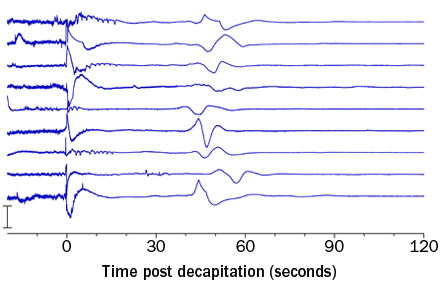‘Wave of death’ may not be a last gasp
Brain may still be living a minute after decapitation
- More than 2 years ago
Almost a minute after a rat’s head is severed from its body, an eerie shudder of activity ripples through the animal’s brain. Some researchers think this post-decapitation wave marks the border between life and death. But the phenomenon can be explained by electrical changes that, in some cases, are reversible, researchers report online July 13 in PLoS ONE.

Whether a similar kind of brain wave happens in humans, and if so, whether it is inextricably tied to death could have important implications. An unambiguous marker could help doctors better decide when to diagnose brain death, knowledge that could give clarity to loved ones and boost earlier organ donation.
In a PLoS ONE paper published in January, neuroscientist Anton Coenen and colleagues at the Radboud University Nijmegen in the Netherlands described this wave of electrical activity in the rat brain occurring 50 seconds after decapitation. The Nijmegen team, which was exploring whether decapitation is a humane way to sacrifice lab animals, wrote that this brain activity seemed to be the ultimate border between life and death. They dubbed the phenomenon the “wave of death.”
But neurologist Michel van Putten of the University of Twente in Enschede, the Netherlands, wasn’t convinced. “We have no doubt the observation is real,” he says. “But the interpretation is completely speculative.”
In the new study, van Putten and colleagues devised a mathematical model of how a nerve cell would behave if its oxygen and energy supplies were suddenly cut off. The model consists of just a single cell with three kinds of channels that allow charged particles to flow in and out. The spaces outside and inside nerve cells have unequal electrical charges, a difference that allows neurons to fire the impulses they use to communicate.
After an abrupt halt of energy and oxygen supply, the channels stop functioning normally, causing a buildup of positive charge outside the cell. This buildup prompts a big discharge of electrical activity about a minute after starting the simulation — the wave of death.
Study coauthor and physicist Bas-Jan Zandt, also of the University of Twente, says that the simulation closely matches what is observed in the rat brain. Such cell behavior could be the start of a damaging process, he says, such as cell swelling, but there’s nothing about the actual wave that means the nerve cell is going to die.
“It doesn’t cause damage to the cell,” Zandt says. “In principle, it is a reversible process.”
The observed brain wave may represent an event on the way to death, but probably isn’t death itself, says clinical neurophysiologist Kevin Nelson of the University of Kentucky in Lexington. Coenen, coauthor of the earlier study, says he was happy to see the modeling experiment. “It nicely shows what we already expected,” he says of the study’s finding that the wave is due to a massive change in cell membrane charge. Yet he still thinks that this wave may be an irreversibly damaging process, and he and his team plan to test this.







